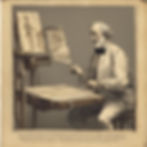Who Invented the Flip Book?
- FLIP BOOK STAR
- Aug 23, 2024
- 4 min read
The flip book, a charming and simple device, has been captivating audiences for over a century. Though often overlooked in today’s digital world, flip books were revolutionary in their time. They were among the earliest forms of animation and have influenced modern media in ways we might not immediately recognize. This blog post delves into the history of the flip book, explores who invented it, and examines its lasting impact on animation and storytelling.
The Birth of the Flip Book
Early Beginnings of Animation
Animation, as we know it today, owes much of its development to the 19th century, a period rich with inventions that laid the groundwork for moving images. Before the advent of film, early inventors sought ways to create the illusion of motion using still images.

One of the earliest devices was the Phenakistoscope, invented by Joseph Plateau in 1832. This device used a spinning disk of sequential images viewed through small slits to create a looping animation. Similarly, the Zoetrope, created by William George Horner in 1834, was another precursor to the flip book, utilizing a rotating cylinder with images viewed through slits to simulate motion.
These inventions demonstrated that by rapidly displaying a sequence of images, the human brain could be tricked into perceiving movement—a principle that would become central to the development of the flip book.
Who Invented the Flip Book?
The flip book, also known as a flick book, was officially patented in 1868 by John Barnes Linnett, a lithographer from Birmingham, England. Linnett’s invention was called the "Kineograph," which means "moving picture." Unlike previous devices that relied on spinning or rotating mechanisms, the Kineograph used a series of sequential images bound together in a book format. By flipping the pages rapidly, a viewer could see the images in motion, creating a simple yet magical animation.
Linnett’s flip book was a significant leap forward because it was more accessible and easier to use than earlier animation devices. It didn’t require any special equipment—just the simple action of flipping through the pages with your thumb.

Evolution and Popularity of the Flip Book
Expansion into Popular Culture
Following its invention, the flip book quickly gained popularity. It became a favorite among children and adults alike, often featuring scenes of everyday life, comical characters, and simple narratives. Flip books were sold as novelty items, included in children’s books, and even used in advertising.
During the late 19th and early 20th centuries, flip books were mass-produced and distributed widely. They were a popular form of entertainment before the widespread availability of cinema and were even used in early movie projectors as part of the film industry’s development.
Technological Advancements
As technology advanced, so did the flip book. In the early 20th century, companies began producing flip books with more complex animations and higher quality printing. Some flip books were even designed with dual narratives, where flipping the book one way showed one story, and flipping it the other way revealed another.
The introduction of motion pictures and animation eventually overshadowed the flip book, but it never disappeared entirely. Flip books continued to be produced as a novelty item and educational tool, and they experienced a resurgence in popularity during the 1960s and 70s, particularly as a form of artistic expression.
The Flip Book’s Influence on Modern Media
Early Animation and Film
The flip book's simple yet effective animation technique directly influenced the development of early animation and film. The concept of sequential images creating motion laid the groundwork for more sophisticated animation techniques. Pioneers of early film and animation, such as Eadweard Muybridge and the Lumière brothers, built upon the principles demonstrated by flip books.
Contemporary Uses
Today, flip books are often used in educational settings to teach the basics of animation and the science of motion perception. They are also popular as a form of artistic expression, with artists creating intricate and imaginative flip books that push the boundaries of the medium.
Additionally, flip books have found a niche in marketing and advertising. Companies use them as a unique and memorable way to convey messages, combining the tactile experience of a physical book with the visual appeal of animation.
FAQs
1. What is a flip book?
A flip book is a small book with a series of images that, when flipped quickly, create the illusion of motion.
2. Who invented the flip book?
The flip book was invented by John Barnes Linnett in 1868, and he called it the "Kineograph."
3. How did the flip book influence modern animation?
The flip book's principle of sequential images creating motion laid the foundation for modern animation techniques and film.
4. Are flip books still made today?
Yes, flip books are still made today, often as a form of art, education, and marketing.
5. What are some modern uses of flip books?
Flip books are used in education to teach animation basics, in art as a creative medium, and in marketing as a unique promotional tool.
Conclusion
The flip book may seem like a simple toy, but its impact on the world of animation and storytelling is profound. From its invention by John Barnes Linnett in 1868 to its enduring presence in modern media, the flip book represents a key moment in the history of visual entertainment. While technology has advanced far beyond the simple mechanics of flipping pages, the flip book’s influence can still be seen in the art and animation of today.
Flip Book Star Official Website 👉 www.flipbookstar.com
Telegram Channel 👉 https://t.me/flipbookstar
Instagram Channel 👉 https://instagram.com/flipbook_star
Facebook Channel 👉 https://www.facebook.com/FLIPBOOKSTAR
Twitter Channel 👉 https://twitter.com/FLIP_BOOK_STAR
LinkedIn Channel 👉 https://www.linkedin.com/company/flip-book-star/
YouTube Channel 👉https://www.youtube.com/@FLIPBOOKSTAR/






